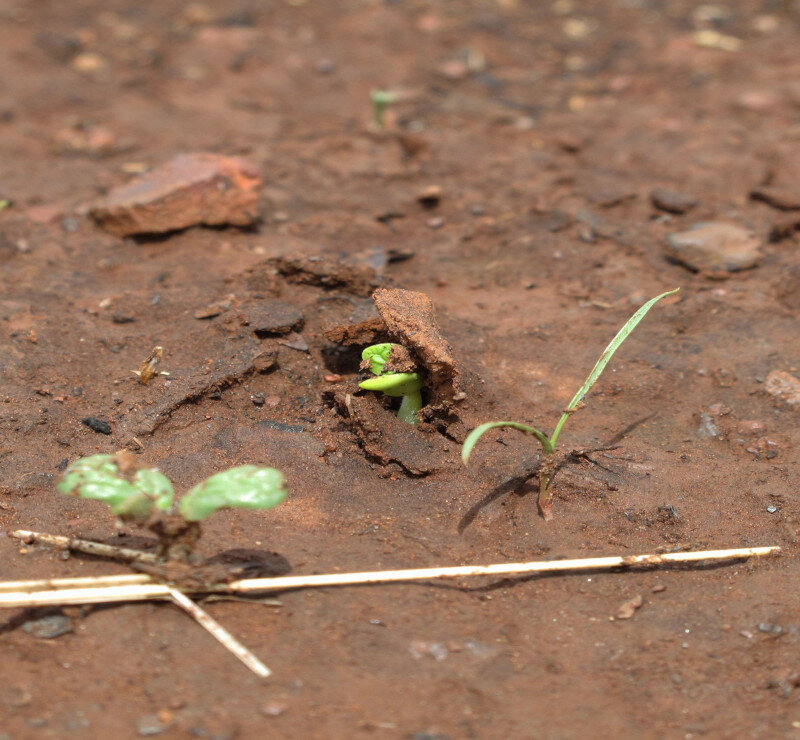by Nancy Shackelford, University of Victoria, School of Environmental Studies, Victoria, British Columbia, Canada
As a restoration practitioner, I hope that every time I put a seed in the ground, I’ve done a bit of good in the world. At the same time, I sit on the edge of my seat after adding thousands of seeds, waiting for that one individual to emerge and make it to adulthood. Sometimes, that back and forth makes it hard to understand if my restoration work is making a consistent difference across the landscape. Scaling from my own work to all of our combined efforts in restoration is even more mind-bending.
The analyzed database contained restoration outcomes from 174 sites on six continents (black dots). This first analysis focused on arid regions globally (aridity index < 0.65; shown as a red-blue gradient for driest-wettest), but future analyses will expand beyond drylands.
That was part of the inspiration behind our new publication in Nature Ecology & Evolution (Shackelford et al. 2021). When a global community of restoration practitioners pools their results and collaboratively assesses what we achieve worldwide, do we end in a place of hope, or frustration? It turns out, we end in both. Our project, the Global Arid Zone Project, brought together vegetation results from 89 seed-based restoration projects in dryland systems worldwide to ask, how successful are we when we seed? What drives that success? The data included 174 sites on six continents, encompassing 594,065 observations of 671 plant species.
A variety of lifeforms emerges from seeding trials in the Australia Pilbara region. Photo by N. Shackelford
We found that seeding is probably necessary in these systems. With only a few exceptions, seeding significantly improved the chances of finding key species compared to unseeded areas. In 30% of projects, every single species that was seeded was recorded in the first growing season. That’s huge! It emphasizes that these added propagules do help return species to each site. Unfortunately, it’s only one side of the story. We also found that it was difficult to get more than 10 species after seeding, no matter how many were in the seed mix. When we broke results down on a species-by-species basis, 57% of seeded species totally failed. In other words, they weren’t found in any of the monitoring after they were seeded. That means the 30% of projects mentioned above were generally low diversity mixes, and even though seeding is helpful, we still have a long way to go before we are achieving consistent, high diversity returns.
There were hints at how we can improve. Increasing seed rate increased success but only up to a point – identifying that threshold of diminishing returns can help minimize overseeding. In addition, species identity explained a lot of the variation in the data. If we can build a global understanding of which species may be the “low hanging fruit”, we can rely on these workhorse species, and then focus more time and effort on the trickier, potentially more desirable species.
As the database grows, we will be able to test questions such as which application method (like drill seeding, shown here) is most effective and under what conditions. Photo by O. Baughman.
Ultimately, much in the database is unexplored, and it continues to grow rapidly. We have merged with the Global Restore Project, led by Dr. Emma Ladouceur out of iDiv, and are continuing to collect seed-based restoration outcomes, now across all climates. New analyses have begun, and we are working hard on an online tool for wider access. We hope to create a living database that is free and open, and might be visually explored by anyone who could benefit. To join the newsletter and follow the project progress, sign up at the bottom of the page here. We also welcome any and all collaborators and ideas, so please email the author if you are interested in discussing the project further.
Shackelford, N., Paterno, G.B., Winkler, D.E. et al. Drivers of seedling establishment success in dryland restoration efforts. Nature Ecology & Evolution (2021). https://doi.org/10.1038/s41559-021-01510-3



